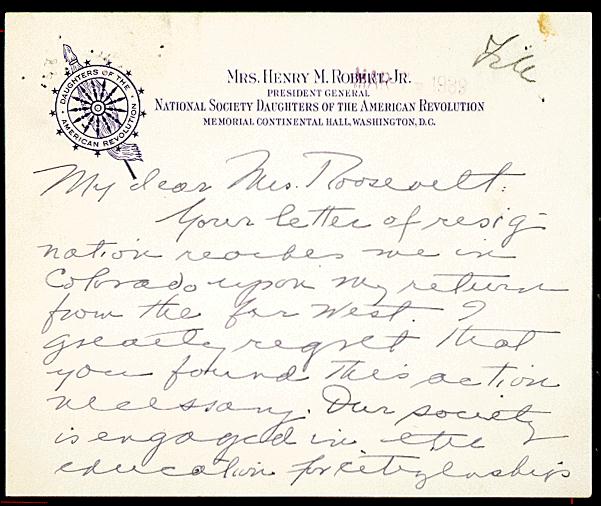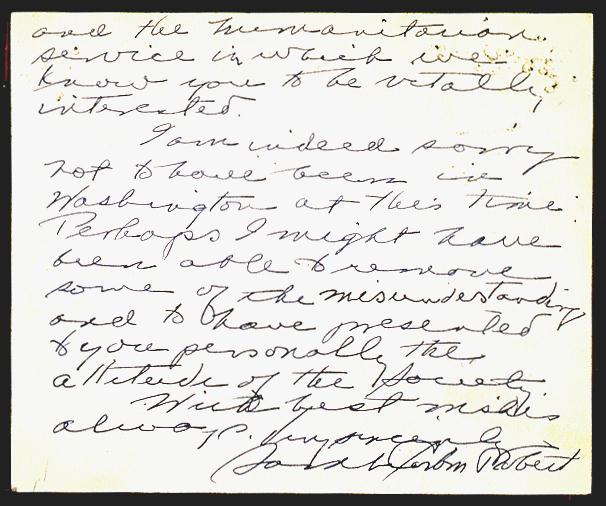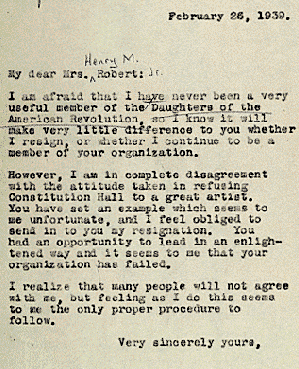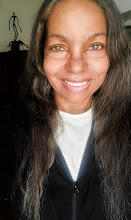Marian Anderson and Eleanor Roosevelt Cut Path through Jim Crow Laws in 1939 at the Lincoln Memorial.
 |
Eleanor Roosevelt (left) presents Marian Anderson (right) the NAACP 1939 Spingarn Medal
Awarded each year for outstanding achievement by an African American.
|
Marian Anderson sang a historic concert at the Lincoln Memorial in 1939, more than a quarter of a century before the Lincoln Memorial became the location of the Martin Luther King "I Have a Dream Speech" at the conclusion of the March on Washington in 1963.
Eleanor Roosevelt was deeply angered when the Daughters of the American Revolution (DAR) refused to grant Marian Anderson a contract to sing at Constitution Hall on the grounds that she was a black performer. In response, Eleanor Roosevelt arranged for Marian Anderson to perform a concert at the Lincoln Memorial, forging the path for Rosa Parks 16 years later to lead the Montgomery Bus Boycott, which launched the career of Martin Luther King and led to King's "I Have a Dream Speech" at the conclusion of the March on Washington.
DAR's action against Marian Anderson was directed by Jim Crow law and tradition.
"The DAR had adopted a rule excluding African-American artists from the Constitution Hall stage in 1932 following protests over "mixed seating," blacks and whites seated together, at concerts of black artists. You may read a 2-page letter from Mrs. Henry M. Robert, Jr., president general of the DAR, responding to Mrs. Roosevelt's resignation." "From: National Archives and Records Administration)
 |
 Page 1, Letter to Eleanor; Page 2 Letter to Eleanor |
Marian Anderson's application for performance at Constitution Hall was denied, based on her race. Anderson was not permitted to bring song to Constitution Hall for her performance because the Daughters of the American Revolution (DAR), in charge of the facility, did not rent the space to nonwhite performers.
 |
When Eleanor read the letter about the DAR Jim Crow snub toward Marian Anderson's request to book her concert at Constitution Hall, First Lady Roosevelt wrote a letter resigning her membership in DAR and expressing her great displeasure of the organization's treatment of Marian Anderson. The First Lady Roosevelt, then went about making alternative arrangements for the Marian Anderson concert at the Lincoln Memorial. African American opera singer, Marian Anderson, sang on the steps of the Lincoln Memorial and her performance launched her as the voice of the Civil Rights Movement. The audience was silent as Anderson presented her program with dignified presence, commanding respect of the universe.
First Lady Eleanor Roosevelt arranged Marian Anderson's concert at the Lincoln Memorial, which, in retrospect, a great number of Americans thought was a far more appropriate location for the concert than Constitution Hall, denied to Anderson by DAR.
 |
The civil rights activism of First Lady Eleanor Roosevelt did not begin or end with the Marian Anderson affair. The daughter of the brother of President Theodore Roosevelt, Eleanor like learned her politics at the dinner table. Being of independent mind from the start and maturing into an independent person of action, Eleanor became force with which to be reckoned.
After marrying Franklin Roosevelt and then becoming First Lady, her columns, speeches, journals were captured in print. Behind the scenes it is said that she influenced the president's racial tolerance, although, not so much his actual civil rights policies, which were avoided due to southern dominance of the Democratic party.
The First Lady's philosophy is published in books, newspapers and magazines. So, it was no surprise that the Marian Anderson concert was arranged by First Lady, Eleanor Roosevelt, when the Daughters of the American Revolution refused to honor Anderson's application for a license to perform at Constitution Hall in Washington DC. The policy of the segregated city of Washington supported their decision. Anderson "was not white," her manager Sol Hurok was told by facility administration.
 |
Until her death in 1962, Eleanor Roosevelt was a dedicated supporter of civil rights. Her social activism dates back to the 1939 Marian Anderson and DAR controversy over the use of Constitution Hall in Washington DC, the establishment of the Tuskegee Airmen in World War II and support of the peaceful protest doctrine of Martin Luther King.
"Charles Alfred Anderson, the first African American to earn a U.S. pilot's license, became the first flight instructor when the Civilian Pilot Training Program (CPTP) was organized at Tuskegee Institute in October 1939. The army decided to model its training program on the CPTP and hired Anderson to teach the Tuskegee pilots," Eleanor Roosevelt Papers Project.
From 1949 until she died in 1962, Eleanor Roosevelt wrote a column in McCall's, If You Ask Me, in which the former First Lady answered reader questions. In 1963, the same year as the March on Washington, Roosevelt's quotations were collected and published.
 |
| Marian Anderson at Lincoln Memorial |
Marian Anderson's concert at the Lincoln Memorial attracted an orderly racially mixed audience of more than 75,000 in defiance of Jim Crow, evolving into its own dignified and cultured protest against Jim Crow racism in America, forging a path for another peaceful protest at the Lincoln Memorial almost a quarter century later--the 1963 Martin Luther King speech, "I Have A Dream" culminating the March on Washington, which attracted an orderly racially mixed audience of more than 200,000 in defiance of Jim Crow racism in America.
Both the March on Washington, led by Martin Luther King, and the Marian Anderson concert drew suspicion of trouble with gatherings so large in the nation's capitol. However, neither reported trouble. They both drew like-minded people who were there to make difference in the way the United States of America conducted its business at home and abroad in regards to race relations in America.
Both the March on Washington, led by Martin Luther King, and the Marian Anderson concert drew suspicion of trouble with gatherings so large in the nation's capitol. However, neither reported trouble. They both drew like-minded people who were there to make difference in the way the United States of America conducted its business at home and abroad in regards to race relations in America.
Marion Anderson, Eleanor Roosevelt and Martin Luther King did the same thing with their powerful voices. And there was no question in my mind after reading and listening to these powerful messages that those in attendance were witnessing history as portrayed by true Americans. Both First Lady Eleanor Roosevelt and opera singer, Marian Anderson, lived to see Dr. Martin Luther King's "I Have a Dream" speech at the Lincoln Memorial in 1963.
- Eleanor Roosevelt was born in 1884 and died in 1962.
- Martin Luther King, Jr., was born in 1928 and died in 1968.
- Marian Anderson was born in 1897 and died in 1993.
No person of any color, creed, religion, ethnic origin, nationality or economic class is more American than Marian Anderson, Eleanor Roosevelt and Martin Luther King, all of whom came upon this earth called to do a duty and none failed in their performance of that duty.
What is the lesson left to the rest of us by the actions of Marian Anderson, Eleanor Roosevelt and Martin Luther King?
What is the lesson left to the rest of us by the actions of Marian Anderson, Eleanor Roosevelt and Martin Luther King?
|
Hard Cover
Amazon Kindle
|
 |
| Sunny Nash |
Sunny Nash is an author, producer, photographer and leading writer on U.S. race relations. She writes books, blogs, articles and reviews, and produces media and images on U.S. history and contemporary American topics, ranging from Jim Crow laws to social media networking. Sunny Nash is the author of Bigmama Didn't Shop At Woolworth's (Texas A&M University Press), about life with her part-Comanche grandmother during the Civil Rights Movement.
Sunny Nash’s book is recognized by the Association of American University Presses as essential for understanding U.S. race relations. Nash's book is also listed in the Bibliographic Guide for black studies at the Schomburg Center for Research in Black Culture in New York; and recommended for Native American collections by the Miami-Dade Public Library System in Florida. Nash uses her book to write articles and blogs on race relations in America through topics relating to her life--from music, film, early radio and television, entertainment, social media, Internet technology, publishing, journalism, sports, education, employment, the military, fashion, performing arts, literature, women's issues, adolescence and childhood, equal rights, social and political movements--past and present—to today's post-racism.
© 2016 Sunny Nash. All Rights Reserved Worldwide.
www.sunnynash.blogspot.com
www.sunnynash.blogspot.com
~Thank You~




Discussion can take us in several directions. The direction taken is up to the individual. What the individual learns from the direction taken is also up to the individual.
ReplyDelete